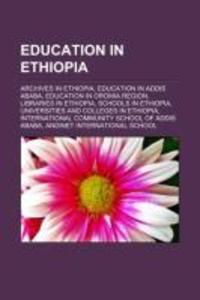Source: Wikipedia. Pages: 26. Chapters: Archives in Ethiopia, Education in Addis Ababa, Education in Oromia Region, Libraries in Ethiopia, Schools in Ethiopia, Universities and colleges in Ethiopia, International Community School of Addis Ababa, Andinet International School, List of schools in Ethiopia, Addis Continental Institute of Public Health, List of universities and colleges in Ethiopia, Bahir Dar University, Arba Minch University, Unity University, Gondar College of Medical Sciences, Addis Ababa University, Rift Valley University College, Jimma University, Mekelle University, Zagol Academy, One Planet International School, The African Children's Educational Trust, PESC Information Systems College, Kunuz College, Haramaya University, Adama University, Mizan Tepi University, Admas College, Theological College of the Holy Trinity, Meki Catholic School, Debre Markos University, Mekelle Institute of Technology, International rankings of Ethiopia, Jijiga University, Saint Mary College, National Archives and Library of Ethiopia, Hawassa University, New Generation University College, Wollega University, Bethel Evangelical Secondary School, Jethro Leadership & Management Institute, Washera College, Bingham Academy, Urban Planning College, Hillside School, Addis Ababa, Ethiopian Civil Service College, HiLCoE College, International Leadership Institute, Infonet College, Zega Business College, Lideta Catholic Cathedral School, Royal College, Addis Abeba, Grace College of Business and Computer Science, Dessie Teacher's Education College, Africa Beza College, Dandii Boruu University College. Excerpt: Education in Ethiopia has been dominated by the Ethiopian Orthodox Church for many centuries until secular education was adopted in the early 1900s. Prior to 1974, Ethiopia had an estimated illiteracy rate well above 90% and compared poorly with the rest of Africa in the provision of schools and universities. After the 1974 revolution, emphasis was placed on increasing literacy in rural areas. Practical subjects were stressed, as was the teaching of socialism. Education received roughly 13% of the national budget in 1992. By 1995 the rate of illiteracy had dropped substantially to 64.5%. Projected adult illiteracy rates for the year 2003 even lower at 61.3% (males, 56.1%; females, 66.6%). As of 1999, public expenditure on education was estimated at 4.3% of GDP.The current system follows very similar school expansion schemes to the rural areas as the previous 1980s system with an addition of deeper renationalisation giving rural education in their own languages starting at the elementary level. The sequence of general education in Ethiopia is eight years of primary school, two years of lower secondary school and two years of higher secondary school. Although the existence of inscriptions prove that literacy preceded the adoption of Christianity as the recognized religion in Ethiopia, by the time of the earliest surviving records formal education was controlled by the church. Educational opportunities were seen as the preserve of Ethiopia's ruling Amhara class. However, these efforts provided educational opportunities to only a few; Samuel Gobat estimated that "where Amharic is spoken, about one-fifth of the male population can read a little, and in Tigre about one twelfth." According to Richard Pankhurst, the traditional education provided by the church began with the learning of the alphabet, or more properly, syllabary, made u...













